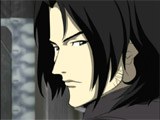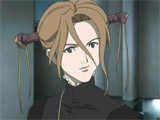

Quick Links:
Witch Hunter Robin, Volume 1: Arrival
Three hundred and twenty years have passed since the coven sank in the dark. I am a hunter. Those who are witches are my prey. I have been trained since a young age to hunt them. Now, I have been given a new hunting ground. They use strange technology here, but I shall not. I shall remain faithful to the old ways.
- from DVD insert, Witch Hunter Robin volume one
Witch Hunter Robin is an interesting specimen. It is a high-budget production that is situated in a witch-of-the-week format - which usually suggests a lack of effort on the storytelling front. In the case of Witch Hunter Robin, this couldn't be further from the truth. Not only is Witch Hunter Robin purposely conservative with the flash factor, its story is subtle and rather deep. The mystery-horror genre has found another winner in this show, with its creepy atmosphere and interesting dualities in symbolism.
Robin Sena, a fifteen year-old "craft user," is the central character of Witch Hunter Robin (though you could have guessed that much without my help). She arrives in Japan from Italy, where she lived in a convent. She's not your typical nun, being that she is a pyrokinetic and dresses all in black. The purpose of her visit is to hunt and capture witches (who seem to be anyone with special powers of some kind) under the direction of the Japan branch of an organization called STN. STN-J members use capsules containing a liquid called Orbo to protect themselves from the witches' powers, and their operation is to capture the witches and send them off to a place called Factory. Robin has a bit of a traditional mindset, and opts not to use the Orbo. She also seems perplexed by the fact that witches are merely captured in Japan.
The first five episodes (making up Volume 1) serve to get Robin settled in to her new job, and to introduce the STN-J members. Her partner is Amon, the obligatory brooding bishounen of the bunch. Then there's Haruto Sakaki and Miho Kurasuma, who are also hunters. The tech whiz Michael Lee acts as a dispatch and runs STN-J's computer systems. Finally we have Yurika Dojima, who doesn't do much of anything except come in late all the time and go shopping on the job. Robin ends up living with a woman named Toko Masaki, who seems to know Amon rather well (but hides it).
The witches that are hunted in the first volume are little more than a villain of the week flavor (though the fifth is poised to make an appearance in the next volume as well), existing solely to showcase Robin's abilities and weaknesses. The appeal of Witch Hunter Robin isn't the conflicts with witches, but what happens behind the scenes. Figuring out who is related to whom, and who is up to something at any given time is enough to keep you busy. The underlying mechanics aren't too confusing, however. The character dialogue is rather cryptic at times, but it is possible to adapt to it. The visuals also play a large role in supporting the mystery of the plot by dropping subtle clues about the characters.
Speaking of the visuals, Sunrise seemed to take special care toward this title. The setting is often dark (but not too dark) or of somber hue, and Robin's flame by contrast is a vibrant orange. Outside of the conflicts, the scenery has more variety and is generally more bright and cheery. The backgrounds make heavy use of CG, which is both good and bad. It's good because it's easy to achieve a sophisticated look with CG, to match the mood of the STN-J office and the nearby Harry's restaraunt (which always seems to be empty, oddly). It's bad because CG texturing has not really come all that far since the beginning, and is still far inferior to both the real thing and the hand-drawn element.
Witch Hunter Robin's character designs are generally rigid and not very revealing, which is fitting for a mystery story. Amon is probably the best example of this, being always dressed in a dark coat and never relaxing. Robin's look is a bit more variant but not by much. Her work dress is dark, but it's almost as if you can see right through her when she has it on. Miho, Yurika, and Michael look more relaxed in appearance, but not to the point of giving away their character. Overall, I enjoyed the character designs and how well integrated they were with the show's atmosphere.
The music of Witch Hunter Robin serves its purpose well, filling the dark scenes with a creepy ambience, and accenting the light scenes appropriately. The opening and ending theme songs (Shell and Half Pain, respectively) are performed by artist Bana, who gives them a sort of moody feel. I found the theme songs to be enjoyable, yet emotionally heavy. It's not meant for lazy Sunday listening, for sure.
Volume 1 of Robin has the distinct honor of being the very first disc in Bandai's platinum line where the "PLATINUM EDITION" banner on the top isn't a total eyesore. That said, Bandai has done an excellent job on all fronts for this release - the only exception I can think of being a few typos in the subtitles (which I hope they are able to fix before the street release). The picture quality for this release is fantastic, and audio isn't far behind. The cover for Volume 1 shows Robin in a sort of pose that looks like she just ran up against a glass wall and is sliding down it slowly. It looks nifty though. The insert is also all about Robin, complete with pictures and that passage at the top of this review. The back of the insert contains credits for the show, as has been Bandai's practice for a while now. I don't normally mention disc menus in my reviews, but I have to give props to the menus in this release. They're very stylish and don't cause you grief performance-wise. The musical accompanyment for the menus is also tasteful. Disc extras include clean opening and closing sequences; character biographies for Robin, Amon, Miho, Yurika, Chief Kosaka, and Zaizen (the top dog at STN-J); and a set of extremely useful liner notes titled "Maelifica Compendium."
The first volme of Witch Hunter Robin has a lot of appeal on its own, and also shows a good amount of promise that the show's mystique will only improve later on. This title is a very easy one to recommend due to the interesting characters and setting. The art style and music aren't too shabby, either. Volume 2 shall be eagerly awaited by yours truly.
(Editor's note: The late 1600s saw a flood of witch hunts. One of the most notable is the Salem witch trials of 1692, but there were also many other notably horrible witch execution sprees, such as the 90 witch killings that occurred in Salzburg (Austria) in 1678 - three hundred and twenty years prior to the airing of Witch Hunter Robin. Whether the quoted phrase at the beginning of this review refers to the Salzburg killings, I am unable to tell.)
Distributor: Bandai Entertainment Creator: Sunrise Released: 2002
Video Quality: A+ Audio Quality: A Presentation: A+ Content: A Overall: A



